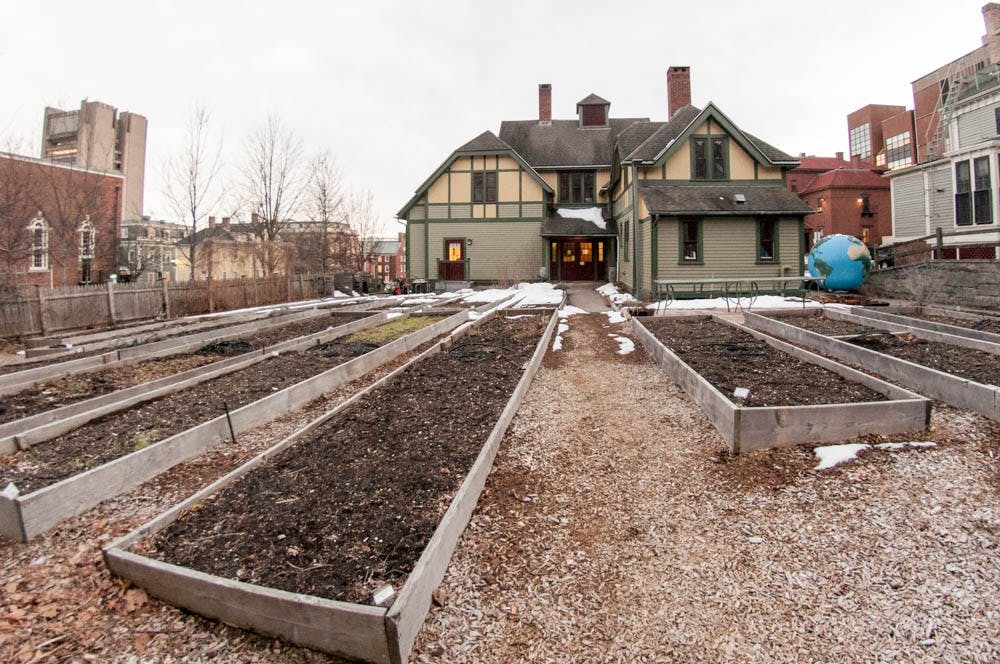Since the University announced the potential demolition of the Urban Environmental Lab to make room for a new performing arts center at the Corporation meeting in February, students and faculty have been pushing to save the UEL and the communities it supports.
The University is currently selecting an architect and designers to validate the site for the new performing arts center — a process which consists of matching the desired characteristics of the proposed building, including number and sizes of rooms, with the proposed location’s size and physical constraints, wrote Associate Provost for Academic Space Leah VanWey in an email to The Herald.
The site where the UEL currently stands must be approved in the site validation process before the Corporation votes on the location during its meeting in May, said Cass Cliatt, vice president of university communications.
There is a possibility that the UEL will not clear the site validation process, said Kurt Teichert, senior lecturer in environmental studies. The East Side Tunnel, now used for public buses, runs fifteen feet under the proposed site and could complicate construction at the site, he said.
The new performing arts center is needed to create a range of spaces available 24/7, according to the Building on Distinction Operational Plan. The plan states that the building, which will contain spaces for music, dance and theater, will be flexible and acoustically appropriate.
The proposed site is ideal for its proximity to buildings central to the arts at Brown, such as Rites and Reason Theater, Leeds Theater and the Granoff Center for the Creative Arts, wrote Executive Vice President for Planning and Policy Russell Carey ’91 MA’06 in an email to The Herald.
The University’s plans to demolish the building have triggered the creation of a petition called “Save the UEL.” Created by Jon Gewirtzman ’17 and Lauren Maunus ’19, the petition has garnered more than 300 signatures from faculty members, students, administrators and alums, among others, according to the petition data. About 16 percent of respondents are current environmental studies concentrators, and another 18 percent of signatories are alums. Sixty percent of respondents are not environmental science concentrators, which “speaks to how many different communities and people use the building,” Gewirtzman said.
The building houses meeting spaces available to students at late hours in the night, a community garden for Providence residents, facilities for Bikes at Brown, market shares, eco-reps, the clothing swap, the Native American and Indigenous Studies program, the Institute at Brown for Environment and Society and the Office of Energy and Environment, Gewirtzman said. The UEL “fosters a really strong sense of community by providing a space” with a kitchen and meeting areas for clubs, Gewirtzman said, adding that informal collaboration occurs often and easily because professors and undergraduates share the space.
Students and faculty members are protesting the plan on the grounds that the UEL has unique historical significance and serves several valuable functions, Gewirtzman said.
There is no way to truly replace the UEL, said Amanda Lynch, director of IBES. “Anything the administration can come up with would be a partial replacement,” she added. The UEL is a living laboratory that embodies the history of environmental technology in buildings, she added.
“It’s the most sustainable building on campus. It was built by students as the original home of the environmental studies program as an example of adaptive reuse and sustainable living,” Gewirtzman said. “It’s a living, very hands-on example of topics that are gone over in a lot of environmental studies classes.”
Originally built to be a carriage house in 1885, the building was modified by students and faculty to explore energy and resource efficient building, Lynch said. “There were a lot of cutting edge experiments and they were layered over each other,” she added.
As a carriage house, the building takes advantage of “passive and active solar orientation … and takes much more advantage of the sun rather than relying on the fossil fuels,” said Teichert.
Solar photovoltaics generate about 10 percent of the building’s current electricity needs, Teichert said. The Katherine Moran Coleman Aquatics Center is the only other building at the University with solar photovoltaics, he added.
The UEL “is my teaching lab,” Teichert said, adding that he uses the building as an example of the energy conservation principles he teaches.
Rather than pushing back against the construction of the new performing arts center, Teichert wants the center to improve on the benefits of the UEL. The “Save the UEL” movement needs to hold fast until the University proves “a viable project is going to supplant these buildings,” he said.
Teichert’s main priority is finding an alternate space that satisfies needs of all the programs currently housed at the UEL. The University has yet to decide where IBES and other programs located in the UEL will be placed, Cliatt said.
“If the worst happens and we’re not able to convince them to save the building, … we need to demand a replacement that fulfills” the needs of IBES, Lynch said.
VanWey has been working with IBES leadership since early 2016 to accommodate program growth and the possible loss of the UEL, VanWey wrote in an email to The Herald.
The University is considering “the feedback in the petition about what makes the space feel different from other IBES spaces or other spaces at Brown,” VanWey wrote.
This is not the first time that the University has discussed demolishing the UEL. The Strategic Framework for Physical Planning, developed in 2003 to support campus planning, listed the UEL as a possible site for construction of a larger building, Carey wrote.
Previous “Save the UEL” campaigns have halted the University’s plans to demolish the building in the past, Teichert said, crediting their success in part to the 2008 recession.
Teichert and Gewirtzman met with the Providence Preservation Society Thursday to discuss the plans to demolish the UEL. Teichert said the purpose of the meeting was to “help (the society) understand the nature of the building.” Though the society does not have the standing to prevent the University from demolishing the building, it can influence the discussion, he added. “I do believe there will be some follow-up,” Teichert said.
Along with the UEL, a parking lot, three residential structures and one other academic building are slated for demolition, according to a University press release.
The University is in ongoing conversations with the city of Providence about physical plans for Brown, Cliatt said. The University is required by law to have an institutional master plan on file with the city. The current version under consideration with the City Planning Commission does not include the plans for the Performing Arts Center because it has not undergone site validation. If the site is approved, the University plans to offer the Performing Arts Center as an amendment to the 2017 plan at a later date.
— Additional reporting by Rhaime Kim





